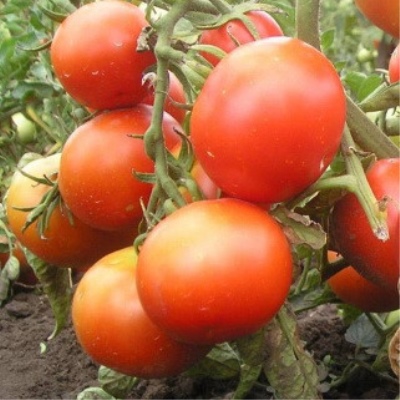
- Authors: VNIIR
- Category: grade
- Growth type: determinant
- Appointment: fresh consumption
- Ripening period: early
- Ripening time, days: 85-95
- Growing conditions: for open ground, for film greenhouses
- Transportability: high
- Bush size: undersized
- Bush height, cm: 50-60
Burkovskiy early has established itself as an unpretentious variety that is perfect for novice summer residents. Tomatoes are allowed to be grown in plastic greenhouses, so Russian gardeners from different parts of the country can enjoy juicy vegetables. Together with other vegetable crops, this variety quickly took root in Russia.
Description of the variety
Depending on the weather conditions, vegetables are cultivated in greenhouses or in open areas. The crop is recommended to be eaten fresh. Growth type is determinant. It is a stunted plant that grows only 50-60 centimeters in height. The green mass is not dense. Leaves of a standard shape, bright green.
The main qualities of the fruit
Ripe scarlet tomatoes are rounded. There is a barely noticeable ribbing near the peduncle. Weight ranges from 150 to 200 grams. The fruits are covered with a dense, shiny skin. Due to the good keeping quality, tomatoes can be stored for a long time.
Taste characteristics
The culinary qualities of the crop are assessed as good. Some people even consider them excellent. The sourness characteristic of most types of tomatoes is absent, but a harmonious sweet taste predominates. The aroma is pleasant and bright, enhancing the taste characteristics of the crop.
Ripening and fruiting
The ripening dates are early and range from 85 to 95 days. This is exactly how much should pass from the moment the seeds germinate to the collection of vegetables. In some regions, the term is increased to 105 days.
Yield
Experts noted the high yield of the variety, and up to 3 kilograms of tomatoes are harvested from one bush. High transportability allows you to grow vegetables for sale.
The timing of planting seedlings and planting in the ground
For growing seedlings, sowing seeds is carried out in mid-March. When planting directly into open ground, work is carried out in mid-May (when grown under film) or at the beginning of summer (for open ground).
It is advisable to prepare the seed in advance by leaving it in a manganese solution for 20 minutes. After that it can be used to obtain seedlings. And they also prepare containers (a large capacity and separate cups, which will be needed for planting seedlings).
Some gardeners germinate seed by wrapping it in a damp cloth and leaving it in a warm place. The fabric should be regularly moistened, but not flooded with water. Otherwise, the seeds will die.

Growing tomato seedlings is an extremely important process, because it largely depends on whether the gardener will be able to harvest at all. All aspects must be taken into account, from seedbed preparation to planting in the ground.
Landing scheme
The maximum planting density should not exceed 3-5 bushes per square meter. Otherwise, the plants will interfere with each other's growth, the fruits will begin to shrink, and their taste will decrease.

Growing and care
To get a rich and stable harvest, you need to properly care for tomatoes. The soil is prepared as soon as it warms up enough. This is a mandatory procedure for both greenhouses and open ground. Nutrients (organic matter, peat or humus) are introduced into the ground. And also the site is treated with a disinfecting composition. For accelerated growth and comfortable development of plants, the territory is dug up
The planting material is often treated with a growth promoter to get the crop as soon as possible. Young bushes are irrigated with warm water. Cold water has a negative effect on the condition of plants and can provoke the appearance of diseases. Such irrigation can even lead to the death of immature plants.
The first time the seedlings are fed on the twentieth day after germination. Fertilizers will help the fruit crop gain strength and then please with the harvest. Ready-made compounds such as humate or nitrophoska are often used.
The grown seedlings are hardened before transplanting to a new place. They are taken out into the street so that they get used to the new conditions. The wells are watered abundantly about an hour before transplanting. Mineral fertilizers are applied to each hole. Adult bushes are watered once a week. Tie up the shoots as they grow, otherwise they may break under the weight of the crop.
Before budding begins, gardeners feed the crop and spray it with a growth stimulant. The soil around the plants is loosened and weeded, removing weeds. They interfere with the development of tomatoes and take nutrients from the soil.




A plant needs different micronutrients at each stage of growth. All fertilizers can be divided into two groups: mineral and organic. Folk remedies are often used: iodine, yeast, bird droppings, eggshells.
It is important to observe the rate and period of feeding. This also applies to folk remedies and organic fertilizers.
Disease and pest resistance
The early Burkovsky variety is highly resistant to many common diseases. Bushes are practically not afraid of late blight and other viruses. In order for a strong immunity not to suffer, constant care is needed for the fruit crop. Failure to comply with agricultural techniques often causes not only a decrease in yield, but also the death of plants.


Resistant to adverse weather conditions
Abrupt climatic changes will not harm the variety. It can withstand extreme weather conditions without any problems, while maintaining the declared positive qualities.

























































































